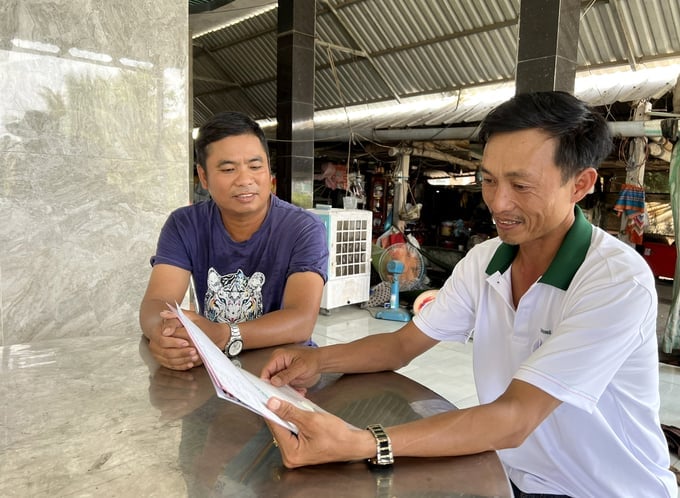June 16, 2025 | 08:38 GMT +7
June 16, 2025 | 08:38 GMT +7
Hotline: 0913.378.918
June 16, 2025 | 08:38 GMT +7
Hotline: 0913.378.918

A dog in Duc Hue district, Long An province wearing a collar displaying its rabies vaccination history. Photo: Thanh Son.
Mr. Tran Xuan Binh, a farmer residing in Hamlet 4, My Quy Tay commune, Duc Hue district, Long An province, was a victim of a rabid dog bite in his own home.
The incident occurred on the morning of April 12, 2024. Upon returning home from the fields, Mr. Binh intended to rest briefly on a hammock suspended beneath a tree. Upon reaching the hammock, he spotted a strange dog lying nearby. When Mr. Binh attempted to chase the dog away, it lunged and bit his calf.
After noticing the dog's unusual symptoms, such as red eyes and a habit of digging to lie down, Mr. Binh suspected it was infected with rabies. Despite the pain, he drove the dog away with a stick, forcing it into the neighbor's garden. The neighbor, whom Mr. Binh promptly alerted of the dog's suspicious behavior, later sought out and killed the dog.
Subsequently, Mr. Binh drove to a vaccination center in Dong Thanh town, Duc Hue District, to receive a dose of rabies vaccine. After administering treatment, healthcare workers at the center advised him to report the suspected rabid dog to the local authorities.
Upon receiving Mr. Binh's report, local authorities dispatched veterinary officers to locate the carcass of the deceased dog, and retrieve samples for testing. Test results confirmed that the dog had been infected with rabies.
Despite having undergone a complete course of costly treatment, Mr. Binh remained anxious and apprehensive, especially given the continued presence of stray dogs within the commune.
Mr. Binh's encounter with the rabid dog occured in My Quy Tay commune, an area with a high vaccination rate. Namely, the vaccination rate for dogs and cats in this commune reached 90% against set targets and 86% against the total population at the end of 2023.
As a victim of stray dogs incidents, Mr. Tran Xuan Binh strongly supports the establishment of local forces specializing in the capturing of stray dogs. Stray dogs pose a significant risk of rabies transmission as well as threaten road safety and community health.
In reality, serious traffic accidents have occurred as a result of motorists colliding with stray dogs on roadways. Mr. Binh shared, "If the commune establishes local forces specializing in the capturing of stray dogs, I will fully support and participate."
Mr. Su Van Ton, a veterinary officer in My Quy Tay commune, attributed the ongoing presence of rabid dogs in the area to local residents expanding their dog and cat populations after each vaccination campaign, as well as the influx of unvaccinated animals from other areas.

Mr. Binh (left) recounting his experience of being bitten by a rabid dog. with a veterinary officer in My Quy Tay Commune. Photo: Thanh Son.
Despite high vaccination rates, rabies infection in dogs, cats, and humans remains a present threat in Long An province. Ms. Dinh Thi Phuong Khanh, Director of the Long An province's Department of Agriculture and Rural Development, reported that the rabies vaccination rate for the province's dog and cat population reached approximately 75% in the first quarter of 2024, with 79,000 doses of vaccine administered. However, rabies outbreaks in dogs and cats are common with six reported cases in the districts of Duc Hoa, Duc Hue, and Tan Hung.
Notably, Tan Hung district reported two fatal cases of rabies in human, and one suspected case currently undergoing treatment at the Ho Chi Minh City Hospital for Tropical Diseases.
Consequently, Mr. Huynh Thanh Hien, Chairman of the Tan Hung District People's Committee, issued a decision on March 7 declaring rabies outbreaks across the district. Additionally, he instructed members of the Steering Committee for the Prevention and Control of Livestock and Poultry Diseases in the district, heads of relevant agencies and units, and chairpersons of local People's Committees to mobilize efforts in containing rabies among animals.

Rabies vaccination for dogs in Duc Hue district, Long An province. Photo: Thanh Son.
Ms. Dinh Thi Phuong Khanh estimated that Long An province houses approximately 100,000 dogs and cats. However, in reality, the total population can range from 150,000 to 170,000 animals.
Due to the significantly underestimated total population, many local dogs and cats are unvaccinated despite the high vaccination rates across multiple districts. On the other hand, the total population of dogs and cats continues to grow at an increased rate. A survey conducted in Duc Hue district by the Faculty of Livestock Production and Animal Health at Ho Chi Minh City University of Agriculture and Forestry revealed that the total population of dogs and cats was 7,082 at the beginning of 2023.
By the end of 2023, the new total had risen to 8,110, marking an increase of over 1,000 animals. Consequently, although the vaccination rate reached 95% compared to the target, it only reached 81% when compared to the new total population.
At the time of vaccination, many dogs and cats that were ineligible for vaccination (due to their young age or pregnancy) were not subsequently given supplementary vaccinations. On the other hand, many pet owners are unaware of the risks associated with rabies, and are negligent in ensuring the vaccination of their pets. Accordingly, they maintain the misconception that pets are immune to the disease.
These factors, in combination with prolonged heatwaves, have led to the emergence of rabies outbreaks among dogs and cats in Long An province in the first quarter of 2024. According to Ms. Khanh, if the extreme weather conditions persist, and the vaccination rate fails to increase, rabies will continue to develop rapidly in Long An province.
In response, the province's government is reinforcing rabies vaccination efforts for dogs and cats, with a focus on Tan Hung district and its neighboring districts. To date, Tan Hung district has achieved a rabies vaccination rate for dogs and cats of over 99%. Similarly, Tan Hung's neighboring districts have also achieved a vaccination rate of over 80%.
Moreover, Long An province is implementing measures to increase the vaccination rate on the actual population. Namely, the province has allocated 91,000 doses of vaccine to districts, towns, and Tan An city within 2024. This figure, although high, is still low compared to the actual population.
With the goal of achieving a vaccination rate of 85% compared to the plan and 80% compared to the actual population in 2024, Long An province has instructed districts, towns, and Tan An City to re-calculate the local dog and cat populations. Furthermore, data collected from future census of local dog and cat populations will be promptly updated into the agricultural database using information technology. This technological deployment will be credited towards the application of information technology in communes and wards.
With the aim of enhancing rabies prevention efforts, veterinary officers in Long An province advocated for the establishment of local forces specializing in the capturing of stray dogs. According to Dr. Truong Dinh Bao, a professor at the Faculty of Livestock Production and Animal Health under Ho Chi Minh City University of Agriculture and Forestry, emphasized that one of the primary reasons behind the prevailing population of unvaccinated dogs in Duc Hue district, Long An province, is the challenge of capturing stray dogs.
Translated by Nguyen Hai Long
![Turning wind and rain into action: [4] Bringing climate bulletins to remote and isolated areas](https://t.ex-cdn.com/nongnghiepmoitruong.vn/608w/files/linhnhp/2025/06/14/1152-z6704423696987_15fd32ffc26d590d204d520c9dac6786-nongnghiep-151141.jpg)
(VAN) The Vietnam Agriculture and Nature Newspaper interviewed Mr. Vu Thai Truong, Acting Head of Climate Change and Environment at UNDP Vietnam, to gain deeper insight into how climate bulletins are delivered to farmers.

(VAN) In Tien Giang, a high-tech shrimp farm has developed a distinctive energy-saving farming model that has yielded promising results.
![Turning wind and rain into action: [3] 300.000 farmers benefit from agro-climatic bulletins](https://t.ex-cdn.com/nongnghiepmoitruong.vn/608w/files/news/2025/06/12/e5a48259d6a262fc3bb3-nongnghiep-125122.jpg)
(VAN) The agro-climatic bulletin has become a valuable tool for farmers in the Mekong Delta. After more than five years of implementation, the initiative is gradually being expanded nationwide.
![Turning wind and rain into action: [2] Providing forecasts to the people](https://t.ex-cdn.com/nongnghiepmoitruong.vn/608w/files/news/2025/06/12/e5a48259d6a262fc3bb3-nongnghiep-103927.jpg)
(VAN) In addition to improving the quality of hydrometeorological forecasts, putting forecast bulletins into practical use is crucial for production and disaster prevention.

(VAN) Blue carbon is receiving attention for its rapid absorption capacity and vast potential. It represents a promising nature-based solution to respond to climate change.
/2025/06/11/3507-1-161904_583.jpg)
(VAN) Seagrass beds and coral reefs serve as 'cradles' that nurture life in the ocean depths, creating rich aquatic resources in Vietnamese waters.
![Turning wind and rain into action: [1] Forecasting for farmers](https://t.ex-cdn.com/nongnghiepmoitruong.vn/608w/files/news/2025/06/11/e5a48259d6a262fc3bb3-nongnghiep-111919.jpg)
(VAN) Weather is no longer just a matter of fate. Forecasts have now become an essential companion for farmers in every crop season.